|
Nazareth
Hometown
of Mary, Joseph and Jesus |
|

View
of the modern city of Nazareth taken from above the city.
Composite
photo. Click here or on photo for
larger image.
Nazareth
is a city of lower Galilee, almost half way
between the southern shore of Galilee (16 miles/26 km) and the
Mediterranean (19 miles/31 km). Located in the hill area north of the
plain of Esdraelon (Jezreel Valley), on a
plateau about 1200 feet (350 meters) above sea level, the rise above
Nazareth climbs almost 400 feet further providing an excellent
panorama of the area. Another nearby landmark, Mt.
Tabor, is 5 miles (9 km) to the east. (Use link on Mt. Tabor to
see a panorama from Nazareth looking toward Mt. Tabor).
Each
reference to Nazareth in Scriptures consistently refer to it as a
city (Greek "Polis", i.e. Matthew 2:23; Luke 2:4) and never
as a village, which presupposes that it must have had a reasonable
size. Yet, a lack of reference to the location in extra-biblical
literature from Old Testament, Inter-Testament, and New Testament
times, imply that it was considered an insignificant place. As such
it was an irrelevant city, distant from major trade routes, looked
down upon by many throughout Israel.
John
1:45-46 Philip found Nathanael and told him, "We have found the
one Moses wrote about in the Law, and about whom the prophets also
wrote - Jesus of Nazareth, the son of Joseph." 46 "Nazareth!
Can anything good come from there?" Nathanael asked. "Come
and see," said Philip. (NIV)
The most
significant person to ever live was born to woman from this
insignificant place - namely Jesus Christ! Most of the events leading
to Jesus' birth centered on this place...
Luke
1:26-39 In the sixth month, God sent the angel Gabriel to Nazareth, a
town in Galilee, 27 to a virgin pledged to be married to a man named
Joseph, a descendant of David. The virgin's name was Mary. 28 The
angel went to her and said, "Greetings, you who are highly
favored! The Lord is with you." 29 Mary was greatly troubled at
his words and wondered what kind of greeting this might be. 30 But
the angel said to her, "Do not be afraid, Mary, you have found
favor with God. 31 You will be with child and give birth to a son,
and you are to give him the name Jesus. 32 He will be great and will
be called the Son of the Most High. The Lord God will give him the
throne of his father David, 33 and he will reign over the house of
Jacob forever; his kingdom will never end." 34 "How will
this be," Mary asked the angel, "since I am a virgin?"
35 The angel answered, "The Holy Spirit will come upon you, and
the power of the Most High will overshadow you. So the holy one to be
born will be called the Son of God. 36 Even Elizabeth your relative
is going to have a child in her old age, and she who was said to be
barren is in her sixth month. 37 For nothing is impossible with
God." 38 "I am the Lord's servant," Mary answered.
"May it be to me as you have said." Then the angel left
her. (NIV)
Luke
1:39-40, 56 At that time Mary got ready and hurried to a town in the
hill country of Judea, 40 where she entered Zechariah's home and
greeted Elizabeth. ... 56 Mary stayed with Elizabeth for about three
months and then returned home. (NIV)
Matthew
1:18-21 This is how the birth of Jesus Christ came about: His mother
Mary was pledged to be married to Joseph, but before they came
together, she was found to be with child through the Holy Spirit. 19
Because Joseph her husband was a righteous man and did not want to
expose her to public disgrace, he had in mind to divorce her quietly.
20 But after he had considered this, an angel of the Lord appeared to
him in a dream and said, "Joseph son of David, do not be afraid
to take Mary home as your wife, because what is conceived in her is
from the Holy Spirit. 21 She will give birth to a son, and you are to
give him the name Jesus, because he will save his people from their
sins." (NIV)
Luke 2:4-5
So Joseph also went up from the town of Nazareth in Galilee to Judea,
to Bethlehem the town of David, because he belonged to the house and
line of David. 5 He went there to register with Mary, who was pledged
to be married to him and was expecting a child. (NIV)
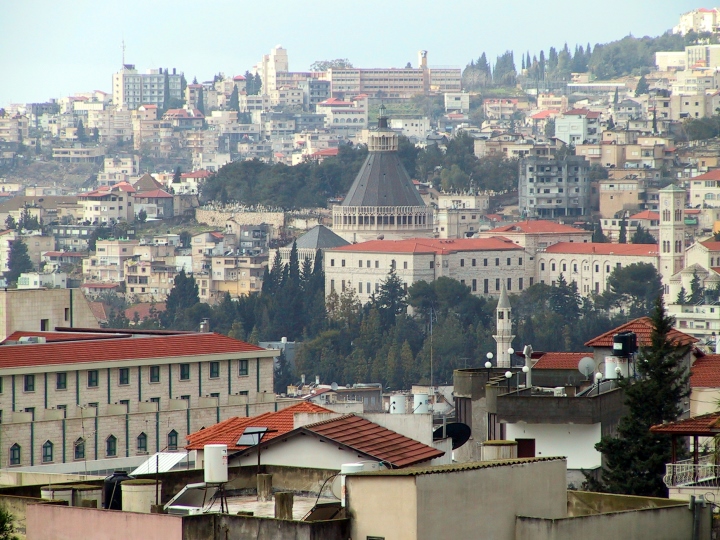
A
closer view of the heart of Nazareth (slightly right of center in
top photo)
Large
dome belongs to the Basilica of the Annunciation (see below)
|
|
Following Jesus' birth in
Bethlehem and their sojourn in Egypt (Matthew 2:13-15), Mary, Joseph
and Jesus returned to Nazareth where Jesus grew to manhood.
Matthew 2:19-23a After
Herod died, an angel of the Lord appeared in a dream to Joseph in
Egypt 20 and said, "Get up, take the child and his mother and go
to the land of Israel, for those who were trying to take the child's
life are dead." 21 So he got up, took the child and his mother
and went to the land of Israel. 22 But when he heard that Archelaus
was reigning in Judea in place of his father Herod, he was afraid to
go there. Having been warned in a dream, he withdrew to the district
of Galilee, 23 and he went and lived in a town called Nazareth. (NIV)
Nazareth remained Jesus'
home before subsequently making Capernaum
his home-base during his brief years of ministry. Significantly, the
people of Nazareth directly rejected Jesus early in his ministry.
Luke 4:16-30 He went to
Nazareth, where he had been brought up, and on the Sabbath day he
went into the synagogue, as was his custom. And he stood up to read.
17 The scroll of the prophet Isaiah was handed to him. Unrolling it,
he found the place where it is written: 18 "The Spirit of the
Lord is on me, because he has anointed me to preach good news to the
poor. He has sent me to proclaim freedom for the prisoners and
recovery of sight for the blind, to release the oppressed, 19 to
proclaim the year of the Lord's favor." 20 Then he rolled up the
scroll, gave it back to the attendant and sat down. The eyes of
everyone in the synagogue were fastened on him, 21 and he began by
saying to them, "Today this scripture is fulfilled in your
hearing." 22 All spoke well of him and were amazed at the
gracious words that came from his lips. "Isn't this Joseph's
son?" they asked. 23 Jesus said to them, "Surely you will
quote this proverb to me: 'Physician, heal yourself! Do here in your
hometown what we have heard that you did in Capernaum.'" 24
"I tell you the truth," he continued, "no prophet is
accepted in his hometown. 25 I assure you that there were many widows
in Israel in Elijah's time, when the sky was shut for three and a
half years and there was a severe famine throughout the land. 26 Yet
Elijah was not sent to any of them, but to a widow in Zarephath in
the region of Sidon. 27 And there were many in Israel with leprosy in
the time of Elisha the prophet, yet not one of them was cleansed -
only Naaman the Syrian." 28 All the people in the synagogue were
furious when they heard this. 29 They got up, drove him out of the
town, and took him to the brow of the hill on which the town was
built, in order to throw him down the cliff. 30 But he walked right
through the crowd and went on his way. (NIV)
Even though Jesus no
longer lived at Nazareth, he was forever identified with this place,
commonly being called Jesus of Nazareth.
Mark 1:23-24 Just then a
man in their synagogue who was possessed by an evil spirit cried out,
24 "What do you want with us, Jesus of Nazareth? Have you come
to destroy us? I know who you are - the Holy One of God!" (NIV)
Mark 10:46-47 Then they
came to Jericho. As Jesus and his disciples, together with a large
crowd, were leaving the city, a blind man, Bartimaeus (that is, the
Son of Timaeus), was sitting by the roadside begging. 47 When he
heard that it was Jesus of Nazareth, he began to shout, "Jesus,
Son of David, have mercy on me!" (NIV)
John 18:3-9 So Judas came
to the grove, guiding a detachment of soldiers and some officials
from the chief priests and Pharisees. They were carrying torches,
lanterns and weapons. 4 Jesus, knowing all that was going to happen
to him, went out and asked them, "Who is it you want?" 5
"Jesus of Nazareth," they replied. "I am he,"
Jesus said. (And Judas the traitor was standing there with them.) 6
When Jesus said, "I am he," they drew back and fell to the
ground. 7 Again he asked them, "Who is it you want?" And
they said, "Jesus of Nazareth." 8 "I told you that I
am he," Jesus answered. "If you are looking for me, then
let these men go." 9 This happened so that the words he had
spoken would be fulfilled: "I have not lost one of those you
gave me." (NIV)
John 19:19 Pilate had a
notice prepared and fastened to the cross. It read: JESUS OF
NAZARETH, THE KING OF THE JEWS. (NIV)
Years later, when Paul
was being tried for his faith in Christ, Christians were likewise
identified with Nazareth.
Acts 24:5-6 "We have
found this man [Paul] to be a troublemaker, stirring up riots among
the Jews all over the world. He is a ringleader of the Nazarene sect
6 and even tried to desecrate the temple; so we seized him. (NIV)
[Compare Matthew 2:23]
|
|
Legends concerning Mary led to many sites being commemorated in
Nazareth and to its becoming
a destination for pilgrims. Traditions aside, some of the sites are
historical, but perhaps not in the way reflected by their founding legends.
Current sites, with some
merit, include:
The Church (Basilica)
of the Annunciation
- professed to be the largest Christian church building in the
Middles East. Roman Catholic tradition holds this to be the site
where the angel Gabriel told Mary she would give birth to Jesus -
Mary's house. Some of the history of this church:
-
Mid 4th Century A.D. -
Early church and altar in the grotto believed to be Mary's house
- Circa 337 A.D. -
Church of the Annunciation commissioned by the Emperor Constantine,
due to efforts of his mother, St. Helena.
- Circa 470 A.D. -
Church of the Annunciation completed
- Circa 570 A.D. - A
pilgrim records that the "house of Mary" was a basilica
- Circa 638 A.D. -
Moslem destroy church.
- Circa 1109 A.D. -
Crusaders build a new and larger church
- Circa 1187 A.D. -
Crusaders defeated at Horns of Hittim, priests butchered here.
- Circa 1263 A.D. -
Church destroyed by Muslims
- 1620 A.D. -
Franciscans purchase the ruins and re-occupy the church
- 1730 A.D. - Church rebuild
- 1877 A.D. - Church enlarged
- 1955 - 1969 A.D. -
Church demolished and rebuilt.
Archaeological
excavations on the grounds of the church have revealed remnants of
earlier churches, plus ruins of Roman era homes, cisterns, grain
storage, and relics. Even items dating back to Canaanite times have
been found. There is little question that the church grounds
encompass a significant portion of early Nazareth.
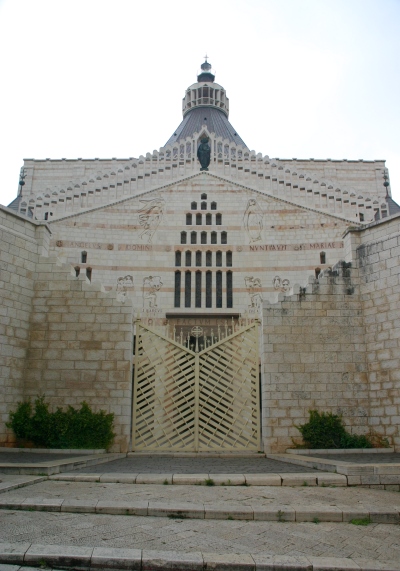
The
Church of the Annunciation from outside the gate
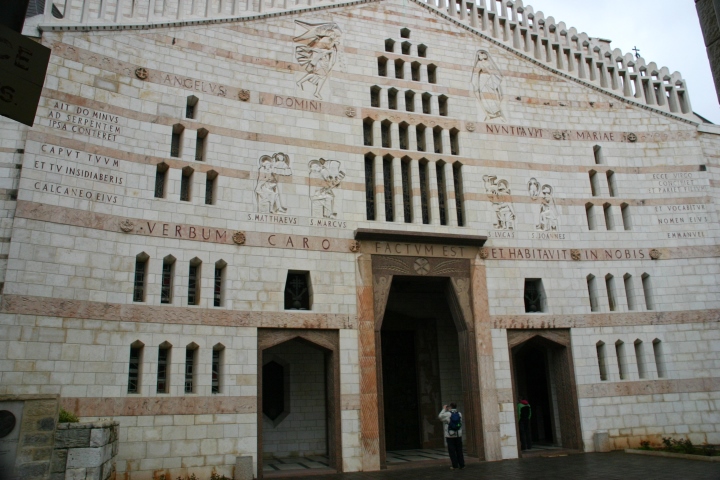
The
Church of the Annunciation inside the gate
Latin
on third stripe up translates as "The Word became flesh and
dwelt among us"
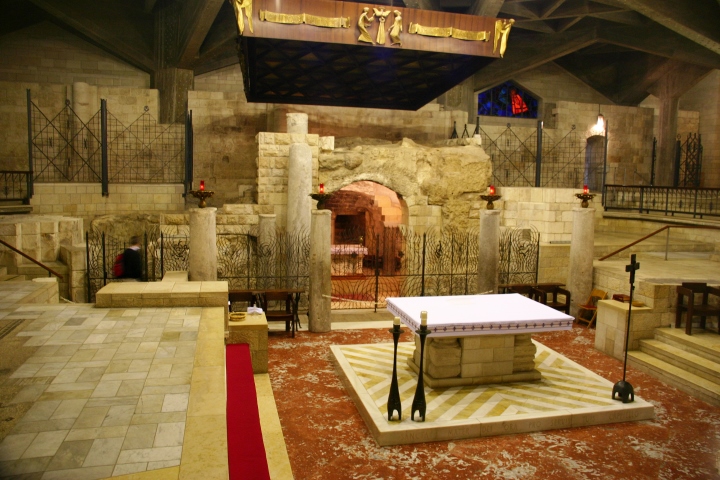
Ruins
incorporated into the lower level of the Church of the Annunciation
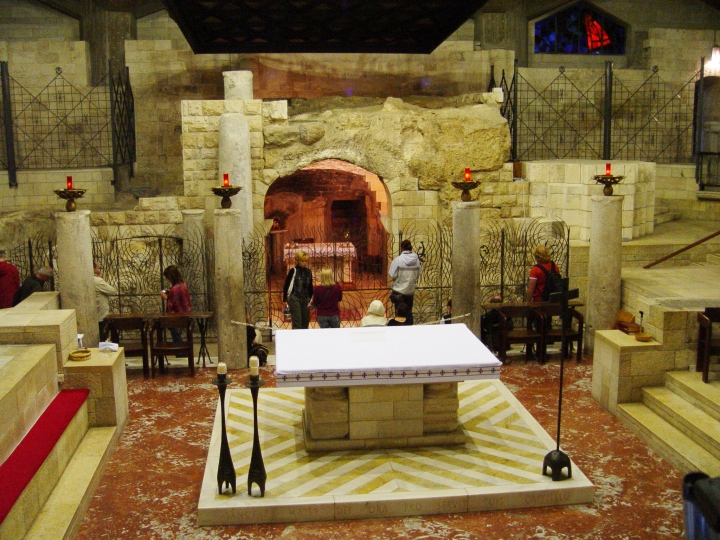
The
altar inside the "cave" is
supposed to be in the house of Mary

Roman
era mikveh or early baptismal font
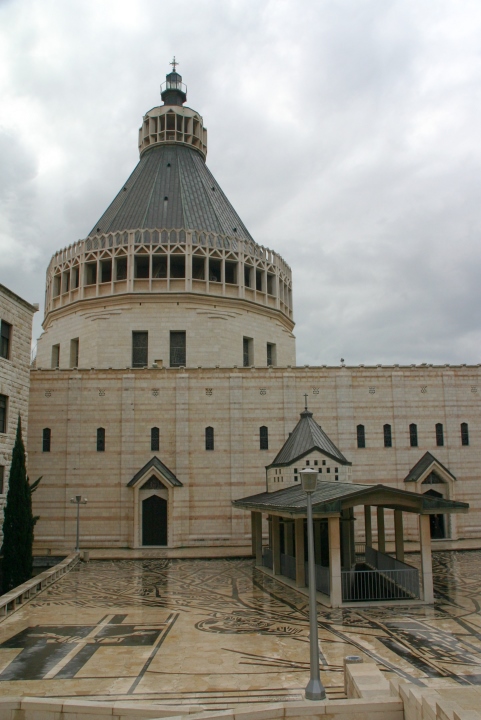
Upper
level and dome at the Church of the Annunciation
|
|
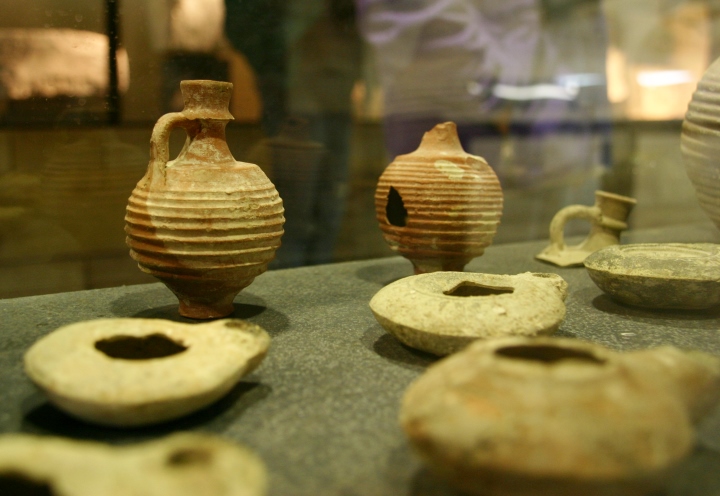
Roman
period artifacts found on the grounds of the Church of the Annunciation
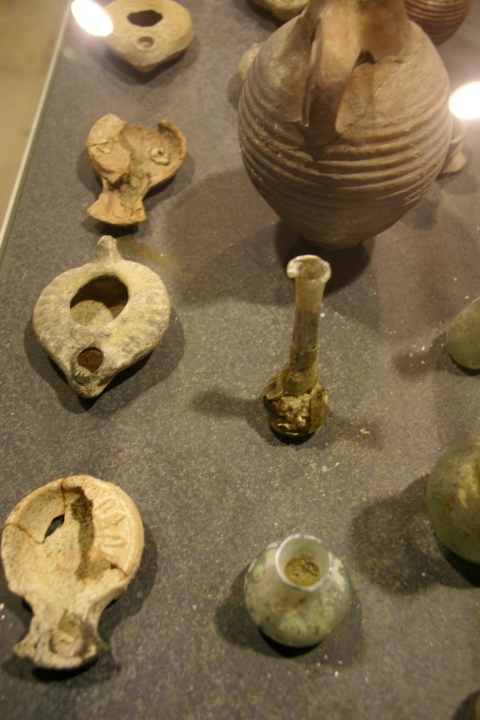
Oil
lamps and more. Tall, thin, glass bottle is a perfume bottle.

Eating
dishes
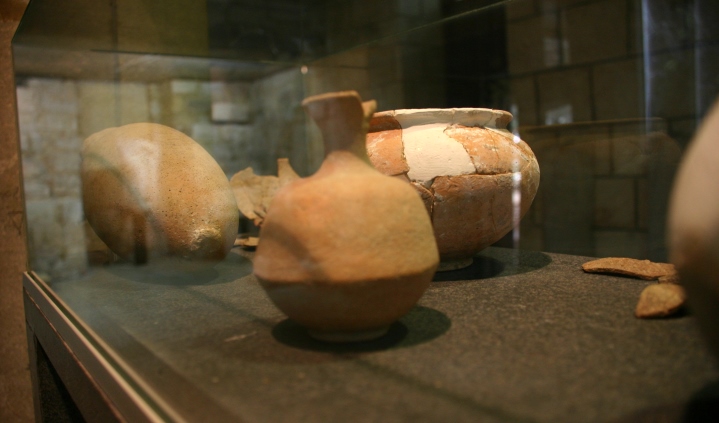
Jugs
and bowls
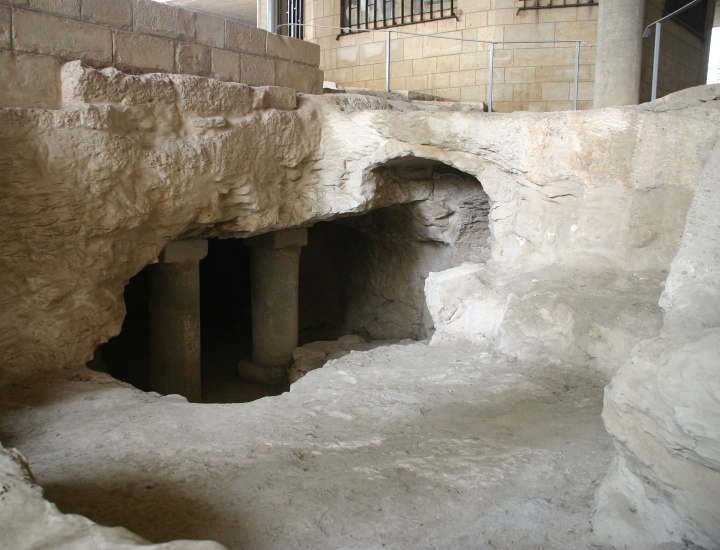
First
century cave style home
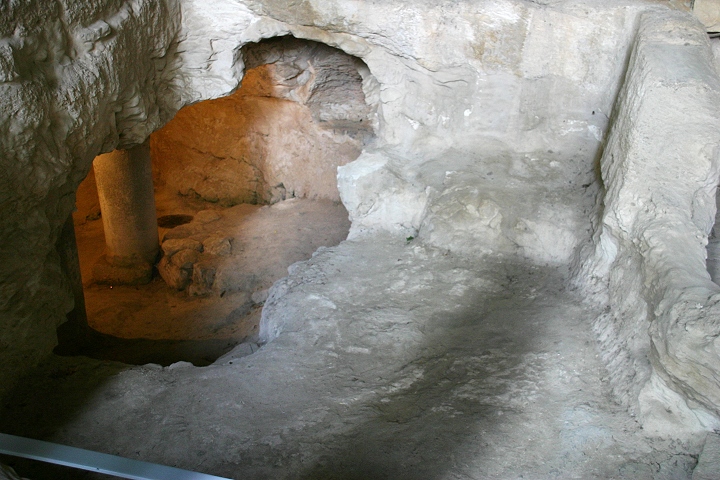
Closer
view. Pillars are modern and were added for support.
Entrance
to home was at the lower right.
|
|
The Eastern (Greek)
Orthodox Church (St. Gabriel's) - Their alternate site for where
Gabriel told Mary she would give birth to Jesus (the Annunciation).
An apocryphal book, written circa 150 A.D., the Protoevangelium of
James (sometimes called the Gospel of James), specifically states the
Mary was drawing water when the angel came to speak with her. Built
over Mary's Spring, one of the ancient water sources of Nazareth.
History records a church being built at this site in the third
century A.D., that was destroyed in the Muslim conquests of the
seventh century. It was rebuilt again by the Crusaders in the 12th
only to be destroyed again at their subsequent defeat in 1263 A.D.
When it was rebuilt in 1767 it was rebuilt atop the ruins of the
Crusader church, leaving the Crusader stonework around the spring intact.
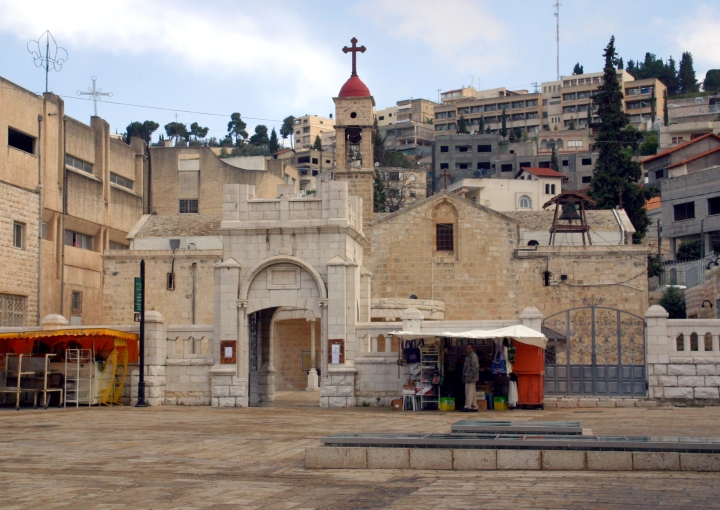
St.
Gabriel's Church from outside the gate
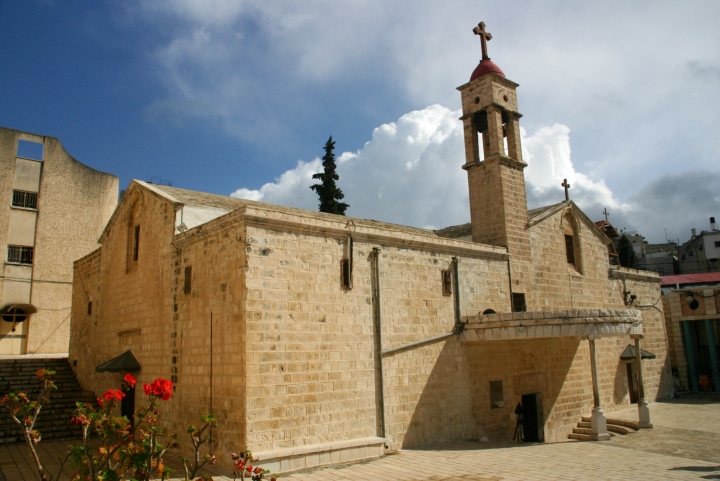
St.
Gabriel's Church from inside the gate
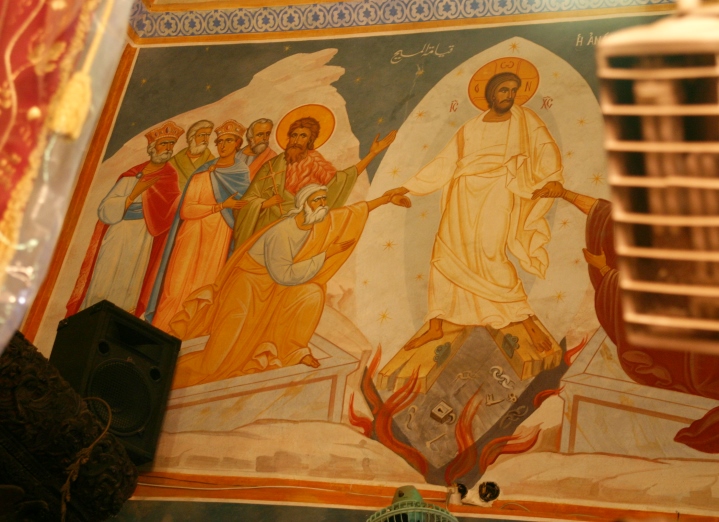
One
of many ancient artwork in the church
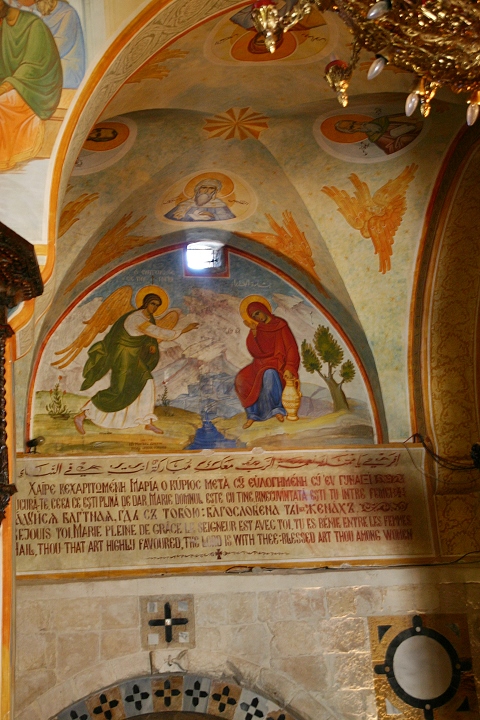
Painting
of angel speaking with Mary at spring.
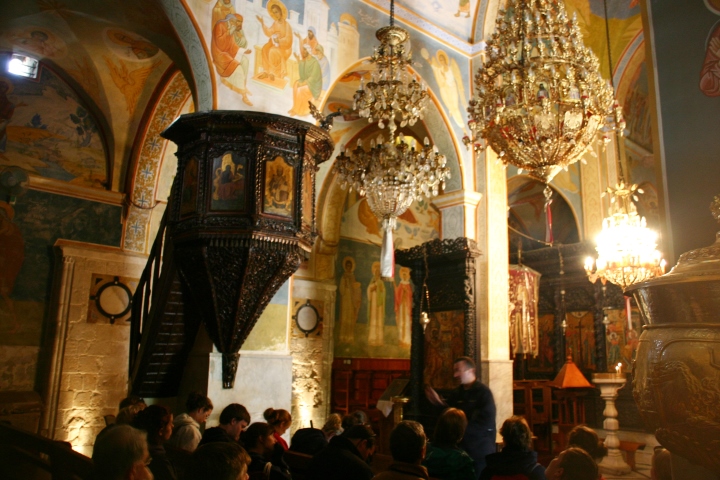
Main
sanctuary in St. Gabriel's Church
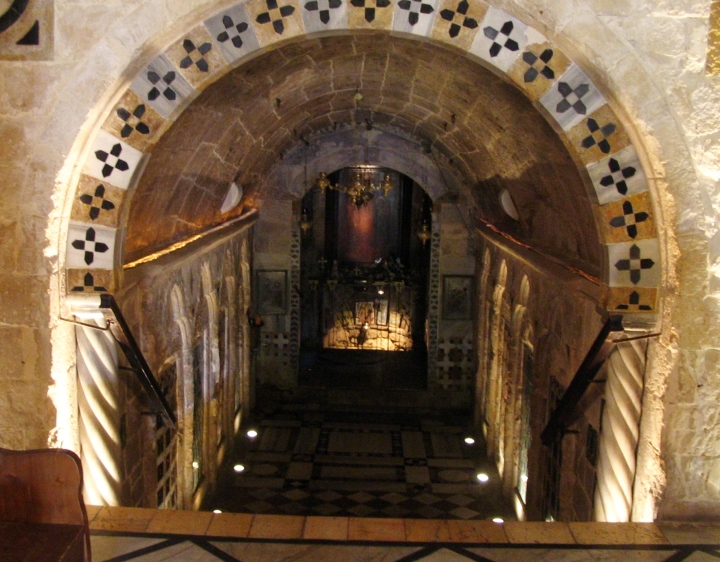
Passageway
to Mary's spring
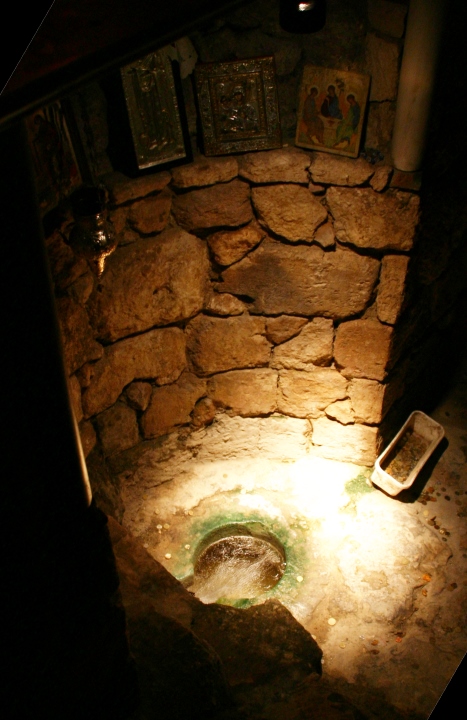
Looking
down to the spring
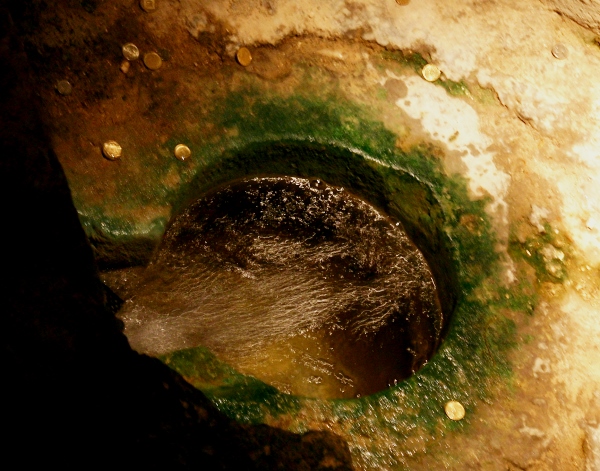
A
large volume of water flows from this spring towards Mary's Well
outside the church
|
|
The
Synagogue Church (next to, and owned by the Melkite Greek
Catholic Church) - Traditional location of the synagogue where Jesus
preached. Built by the Crusaders (circa 12th century A.D.), it is
said to be built over the original Roman period Synagogue. Testifying
to an earlier history, an Italian pilgrim in 570 A.D. described the
synagogue and one of its benches. Click link on title for photos.
Mary's Well and
adjacent Ancient Bath House - Fed by the spring at St. Gabriel's
Church, this is where the residents of Nazareth drew their water for
centuries. In recent times the structure here has been restored to
match the form seen in early photographs and descriptions. Alongside
Mary's Well, owners of a souvenir shop discovered (in the 1990s) that
beneath it was a network of beautifully preserved ancient stone
arches that once supported a large bath house. This bath house was
fed by the same water supplying Mary's Well and included a furnace
and imported white marble floor. This Roman era find may require
reassessment of the common assertion that Nazareth was extremely
small in Roman times. |
|
|